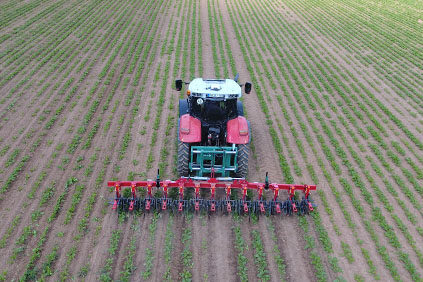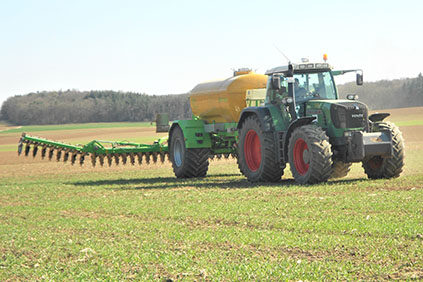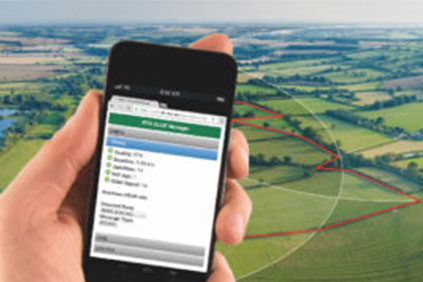Especially on slopes, mounted implements often cannot keep track of the tractor. If they drift, the mounted hoe can damage the crop. Active automatic implement steering, such as that offered by Reichhardt with the PSR SLIDE shifting frame, helps to prevent this. The PSR SLIDE takes up position between tractor and implement. There, it equips all implements available on the farm with the automatic steering system, from the dam cutter to the hoe. In 2019, the unit was redesigned for higher workloads. Demand for the equipment is increasing as more farmers convert to organic farming and do a lot of hoeing.
#Ö spoke with Felix Kleiber, agricultural engineer and product specialist at Reichhardt, about the technology.
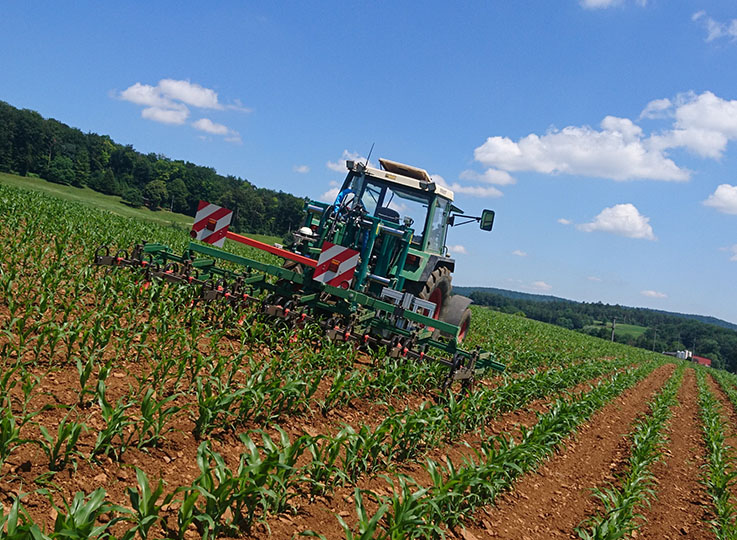
- #Ö: Reichhardt has written the attributes “precise, independent, environmentally friendly” on the SLIDE’s banner. Can you explain where these attributes come from?
Kleiber: Precise means that existing devices in the plant, which do not work precisely, can be made precise. For example, a dam cutter or a hoe. This prevents having to buy the entire machinery from scratch. It also saves on new investments and is sustainable. The precision of the SLIDE is fed by satellite data. The receiver for the signals of the Global Navigation Satellite System(GNSS) is mounted on the shifting frame and tells it where to drive. However, the satellites to which GNSS refers always change their position a little. Therefore, the satellite data is offset with Real Time Kinematic (RTK) correction signals that are referenced to a fixed reference point somewhere on the earth. This allows the exact position to be calculated. If I were to use only satellite data, I would not be able to find a row of corn drilled in the spring when I hoed it. RTK enables an accuracy of plus or minus two centimeters. Through its shifting motion, the SLIDE transfers this precision to the implement. The shifting frame can compensate for 30 centimeters in any direction. This results in a shifting movement of 60 centimeters in total. Before that, of course, you have to set the tracks.
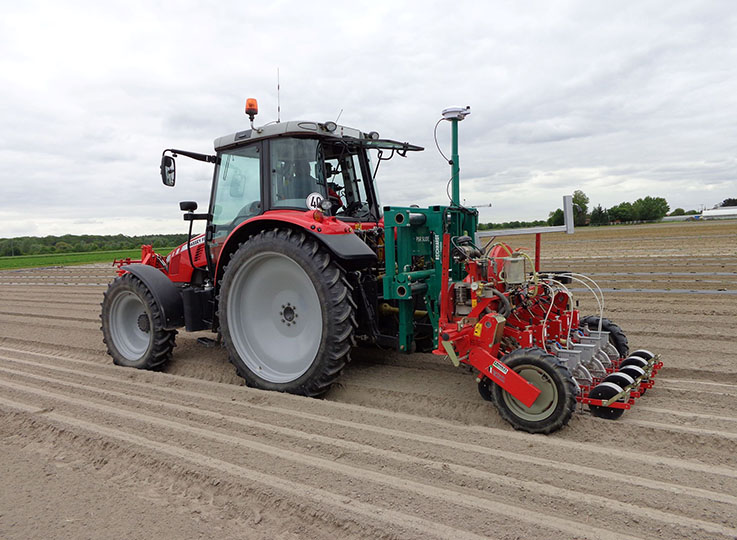
- #Ö: And what does the SLIDE have to do with independence?
Kleiber: The SLIDE is quickly converted and universally applicable. Any standard implement can be attached. Only if you have a PTO-driven implement you might have to buy a longer PTO, because the SLIDE is still in between. If a hoe is factory pre-equipped with a control, you can only control that with it. If you have a shifting frame, you can adjust the entire production to it, without having to buy new equipment: In the spring, the ridge tiller, followed by the drill and finally, at the end the hoe.
- #Ö: Don’t I need any accessories at all if I want to use the SLIDE?
Kleiber: The SLIDE is operated via its own terminal, which you can buy from us. But any other ISOBUS terminal will do. In the case of light tractors and an implement that digs heavily into the ground, it can happen that the shifting frame does not shift the implement, but the tractor. In that case, we recommend mounting flanged wheels. They help keep the tractor on track. In closed stands, a stainless steel leaf deflector is useful as a supplement to the ultrasound.
- #Ö: Speaking of ultrasound. Why doesn’t the SLIDE work with a camera when chopping?
Kleiber: The ultrasonic device can basically do everything a camera can do. But with ultrasonic sensors, we can go even further where it gets difficult for the camera – whether it’s dusty or dark. For example, ultrasound can be used to scan the tops of dams where no crops are growing yet. In addition, the sensor is also based on the height of the plants. Ideally, the weed is then lower than the crop. This means, that ultrasound also works in dense stands or where there are a lot of weeds in the row, which is where cameras fail.
Cameras measure and compare colors and leaf shapes. If the weed and the crop are very similar, or if there are no stands at all, such as in the case of pre-existing dams, the camera reaches its limits.
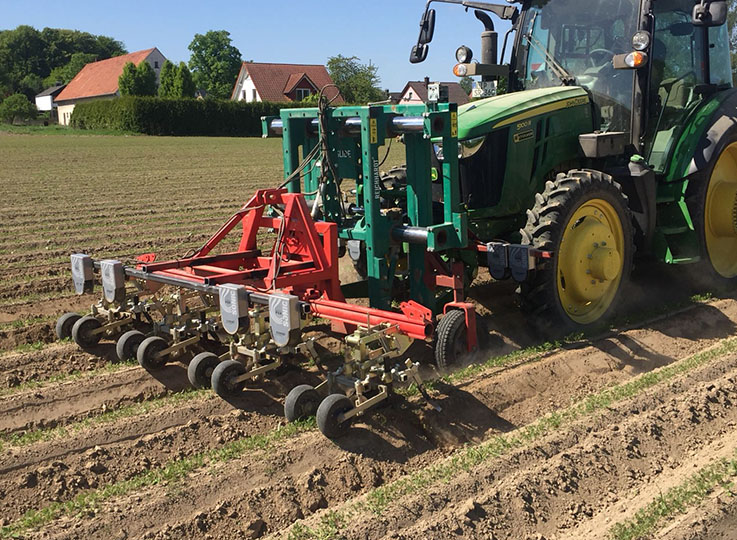
The disadvantage of the ultrasonic sensor is that it can only detect plants from a height of about eight centimeters. But below that, the SLIDE can use GNSS. To make the most of the system’s precision, you should gear your entire crop cultivation to it, i.e. be as precise and accurate as possible right from the first step. If I have already seeded with GNSS, I can still blind hoe before emergence. And if my sub-contractor has used GNSS, I can get the data from him and transfer it to the slide.
- #Ö: What are the limits of the SLIDE?
Kleiber: The load capacity minimally limits the range of applications. A maximum of five tons of static load-bearing capacity at the coupling points is permitted. So a huge potato planter, where there are already four tons of potatoes inside, will be too heavy for the SLIDE. With very wide implements, such as hoes more than nine meters wide or 24-row corn drills, the torsional forces are too great when making slight turns or on uneven ground. Up to about nine meters will work, though. And older worn and worn-out equipment flaps around. Even the SLIDE can’t compensate for that. The implement should be free of play. One advantage is when the tractor is steered automatically, because then the whole combination is more steady in line. Otherwise, if the driver makes a quick steering movement without concentrating, the SLIDE may not be able to keep up.
- #Ö: Do you have any experience of how quickly the purchase of the SLIDE has paid for itself?
Kleiber: It has paid for itself very quickly, especially on vegetable farms, simply because otherwise a lot of chopping has to be done manually. Every centimeter closer to the row saves expensive manual labor. Demand is increasing every year, partly due to the fact that many farms are converting to organic farming. The shifting frame costs between 15,000 and 23,000 Euros, depending on the equipment. This is cheaper than buying completely new equipment. With a new purchase, an accompanied first use is included in the price.
- #Ö: We haven’t talked about the attribute “environmentally friendly” yet.
Kleiber: The SLIDE has a much higher productivity than a non-automatic hoe, since you can easily drive ten to 12 kilometers an hour with it, which reduces fuel consumption per hectare. You also save chopping passes, since you can chop more precisely with the slide frame. It can also be used to apply liquid manure in standing corn, where otherwise it is difficult to find the right row. This means the nitrogen gets to the plant when it needs it.
Source: #Ö – ecologically successful, Theresa Petsch (editor).

